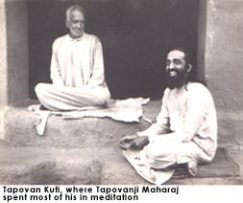– (a fictional story from the understandings from Swami Mitrananda’s talks on Kathopanishad)
(the story below is a continuation of a serious discussion that is taking place between a Teacher and his Student)
Teacher: Where are our thoughts taking place?
Student: In our minds.
Teacher: What is the Mind?
Student: Nothing but flow of thoughts.
Teacher: Good. Do thoughts occupy space?
Student: (Thinking) I’m not sure.
Teacher: Thoughts travel faster than the speed of light. Anything that travels faster than light cannot be matter. So, thoughts and Mind are not matter. Hence, they do not occupy space. If they do not occupy space, then are they in this space?
Student: (Wondering)
Teacher: Let’s try to analyse. Thoughts come and go in split seconds. From where do they come? Unto where they go? Is there a specific place from where they come?
Student: Never thought about it?
Teacher: Thoughts are able to travel so fast because they exist in a dimension that is subtler than space because of which they are able to travel faster than light.
Student: Wow!
Teacher: (Smiling) Next question. Can you show the exact place where mind is located in your body?
Student: Is it the brain?
Teacher: A torch is an instrument through which a battery can function. Similarly, brain is the instrument through which mind works. However, we cannot say that mind is in the brain. Mind is subtler than the brain. When the brain dies (a person dies), the mind and thoughts manifest through someone else. That is why, great people take up great initiatives and even if they die without fulfilling their dreams, it gets manifested through someone else. Swami Vivekananda once said, “If a person takes a strong thought and goes and locks himself inside a cave, and he dies there. The thoughts will penetrate through the rocks and come out. Such is the power of thoughts.” Let us take the examples of freedom fighters who laid down their lives with a dream of achieving freedom. Their thoughts were so strong that others took it up and fulfilled them.
Body is in the dimension of space. Mind is in a dimension subtler than space. Hence, mind cannot be inside the brain.
Student: You are talking about dimensions outside space, and probably time too. But how can we imagine something like that? Even the theory of creation is explained through space and time.
Teacher: To a questioning mind (intellectual mind), all these stories might sound confusing or even ridiculous. That is because he is thinking within the dimension of space and time.
Scientists keep coming with newer and newer theories of creation which usually contradicts the earlier theories. Religious scriptures (of every religion) have given out their theories of creation. To an intellectual mind, most of them sound like interesting stories. But the same person might accept a theory of creation given out with a world-famous scientist (without even questioning it).
Student: Yes. That’s because science is rational. It is based on proofs. We believe something only when it is proved.
Teacher: If that is so, why is the ‘Theory of Creation’ called a ‘Theory’ even by the scientists? Why don’t they say that it is the Truth?
Student: Because it’s a theory, or a hypothesis based on the study made by a scientist or group of scientists.
Teacher: You said it. It is JUST a ‘hypothesis’, an assumption, a probability. But we believe it so strongly that we ACCEPT it as the Truth because Science is saying this. Don’t we?
Student: So, do you mean to say that all these theories of creation given out differently in different religious scriptures are to be accepted too? If that is the case, then which one should we accept? All of them sound like a fairy tale to me.
Teacher: You are right. You might feel these stories like fairy tales but a child would not. If a child asks its grandmother how it rains, the granny would probably say that there is an elephant above the clouds who showers water from the sky and that’s how it rains. For the small child, this story might be enough to satisfy his question. But when the same child grows little old, he questions as to how an elephant can sit in the sky. When the granny sees that he has matured a bit, she gives another story – the elephant is Lord Indra’s elephant, and Lord Indra sits in heaven. His quest is at rest for some time but then he starts questioning Lord Indra’s existence and if there is something called as Heaven? The granny tries giving more stories but the boy is no longer interested in stories. He wants to know nothing, but the Truth. Granny is now happy that he is now seeking the Reality and tells him scientifically how it rains. Had the granny tried explaining him this science when he was very young, he would have got all the more confused.
Knowing this fact, the Rishis gave many stories of the Creation so that people who are of a questioning mind can satisfy their quest. But they knew that these stories would not keep them quiet for a long time and that they would keep enquiring deeper and deeper. And that, if they (the Rishis) could not answer their further questions, they would shun away religion like a bundle of beliefs and superstitions. Hence, the Rishis gave different stories for people who are at different stages of evolution. After a true seeker listens to all these stories, he becomes like the boy who is no longer interested in stories but to know what is the Truth.
To such a student in the Upanishads, the Rishis say, “Till now you were asking about the story of Creation and we gave you the story of Creation. But now, you have asked a deeper question – Is the Creation Real?”
When the student asks this question, the teacher understands that he has become more matured and can digest a Higher Truth. His level of intellect has risen to such a point that even objective sciences fail to answer his questions. To that student, the teacher says, “Contemplate upon this – Is the Creation Real – and Realise the Truth; for, this Truth cannot be explained. It has to be Realised. Explanations are for the Intellect. How can you explain something which is beyond the understanding of the Intellect?”
Student: (Astonished) I’m hearing things like this for the first time. But somewhere it rings a bell in me. I think I’m not matured enough to grasp the essence fully at the moment. I’ll surely contemplate on it.
Teacher: (Smiling) Good. We will wind up the session with a story. A Maths teacher gave a problem to a class of students. He said that it is the toughest problem that he has given till now. He also declared a prize for the one who could solve it. Everyone immediately started working on it. First they attempted individually. But when they saw that they are not able to come to a conclusion, they started working in groups. At some point, a group would arrive at a solution but then for some minor reason, the solution would be wrong. Still they kept trying and presenting their proofs. Days turned into weeks, weeks turned into months. Yet there was none who got the answer. Finally, after a year, they admitted their defeat and asked for the solution to the teacher. The teacher laughed and said, “The problem I gave you was wrong. How can you get a correct solution for a wrong problem?” The students surprisingly ask, “What do you mean?” The teacher replied, “What do you understand when I say, that the problem was wrong? It means, there was no problem at all! How can there be a solution if there is no problem at all? It was your mind that made the problem look real? Had you given a shift to your mind, you could have realized the unreality in the problem.”
With this story in mind, contemplate on these questions – When we try to find out the possible theories of Creation of this world, have we ever given a thought if the world is real? If yes, how? If not, why? Do not conclude anything immediately. Let your mind churn with these questions. Let not the answers come out as Theories but as Realisations.






